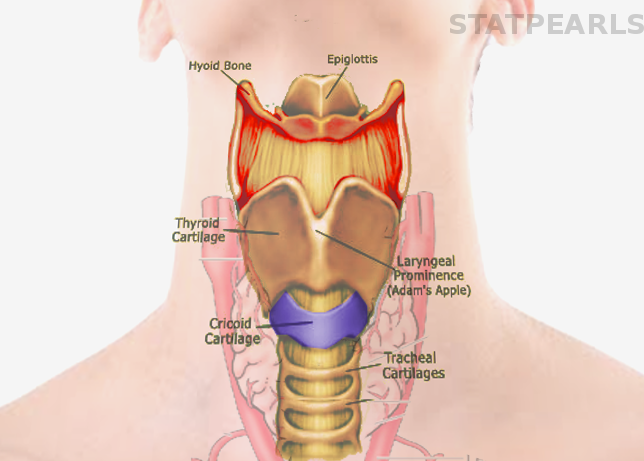[1]
Garbelotti Junior SA, Rocha PR, Liquidato BM, Marques SR, Arráez-Aybar LA, de Moraes LOC. Arch of cricoid cartilage anatomical variation: morphological and radiological aspects. Surgical and radiologic anatomy : SRA. 2019 May:41(5):539-542. doi: 10.1007/s00276-018-2174-2. Epub 2019 Jan 2
[PubMed PMID: 30600337]
[2]
Scrase I, Woollard M. Needle vs surgical cricothyroidotomy: a short cut to effective ventilation. Anaesthesia. 2006 Oct:61(10):962-74
[PubMed PMID: 16978312]
[3]
Siribumrungwong K, Sinchai C, Tangtrakulwanich B, Chaiyamongkol W. Reliability and Accuracy of Palpable Anterior Neck Landmarks for the Identification of Cervical Spinal Levels. Asian spine journal. 2018 Feb:12(1):80-84. doi: 10.4184/asj.2018.12.1.80. Epub 2018 Feb 7
[PubMed PMID: 29503686]
[5]
Saran M, Georgakopoulos B, Bordoni B. Anatomy, Head and Neck, Larynx Vocal Cords. StatPearls. 2023 Jan:():
[PubMed PMID: 30570963]
[6]
de Bakker BS, de Bakker HM, Soerdjbalie-Maikoe V, Dikkers FG. The development of the human hyoid-larynx complex revisited. The Laryngoscope. 2018 Aug:128(8):1829-1834. doi: 10.1002/lary.26987. Epub 2017 Dec 8
[PubMed PMID: 29219191]
[7]
Reidenbach MM. Borders and topographic relations of the cricoid area. European archives of oto-rhino-laryngology : official journal of the European Federation of Oto-Rhino-Laryngological Societies (EUFOS) : affiliated with the German Society for Oto-Rhino-Laryngology - Head and Neck Surgery. 1997:254(7):323-5
[PubMed PMID: 9298667]
[8]
Regner MF, Tao C, Ying D, Olszewski A, Zhang Y, Jiang JJ. The effect of vocal fold adduction on the acoustic quality of phonation: ex vivo investigations. Journal of voice : official journal of the Voice Foundation. 2012 Nov:26(6):698-705. doi: 10.1016/j.jvoice.2011.09.012. Epub 2012 May 11
[PubMed PMID: 22578437]
Level 2 (mid-level) evidence
[9]
Randestad A, Lindholm CE, Fabian P. Dimensions of the cricoid cartilage and the trachea. The Laryngoscope. 2000 Nov:110(11):1957-61
[PubMed PMID: 11081618]
[10]
Fayoux P, Devisme L. Histoanatomical structures of laryngeal atresia: Functional considerations. The Laryngoscope. 2020 Jan:130(1):252-256. doi: 10.1002/lary.27855. Epub 2019 Feb 8
[PubMed PMID: 30734293]
[11]
Langvad S, Hyldmo PK, Nakstad AR, Vist GE, Sandberg M. Emergency cricothyrotomy--a systematic review. Scandinavian journal of trauma, resuscitation and emergency medicine. 2013 May 31:21():43. doi: 10.1186/1757-7241-21-43. Epub 2013 May 31
[PubMed PMID: 23725520]
Level 1 (high-level) evidence
[12]
Patel SA, Meyer TK. Surgical airway. International journal of critical illness and injury science. 2014 Jan:4(1):71-6. doi: 10.4103/2229-5151.128016. Epub
[PubMed PMID: 24741501]
[13]
Macchiarini P, Verhoye JP, Chapelier A, Fadel E, Dartevelle P. Partial cricoidectomy with primary thyrotracheal anastomosis for postintubation subglottic stenosis. The Journal of thoracic and cardiovascular surgery. 2001 Jan:121(1):68-76
[PubMed PMID: 11135161]
[14]
de Vincentiis M, Greco A, Fusconi M, Pagliuca G, Martellucci S, Gallo A. Total cricoidectomy in the treatment of laryngeal chondrosarcomas. The Laryngoscope. 2011 Nov:121(11):2375-80. doi: 10.1002/lary.22337. Epub
[PubMed PMID: 22020889]
[15]
Zeidan A, Ramez Salem M, Khorasani A. Surface anatomical landmarks or ultrasound for cricoid pressure application. Anaesthesia. 2019 Jan:74(1):121. doi: 10.1111/anae.14522. Epub
[PubMed PMID: 30511751]
[16]
Birenbaum A, Hajage D, Roche S, Ntouba A, Eurin M, Cuvillon P, Rohn A, Compere V, Benhamou D, Biais M, Menut R, Benachi S, Lenfant F, Riou B, IRIS Investigators Group. Effect of Cricoid Pressure Compared With a Sham Procedure in the Rapid Sequence Induction of Anesthesia: The IRIS Randomized Clinical Trial. JAMA surgery. 2019 Jan 1:154(1):9-17. doi: 10.1001/jamasurg.2018.3577. Epub
[PubMed PMID: 30347104]
Level 1 (high-level) evidence

